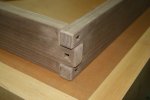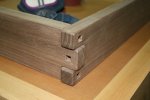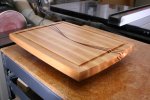Dale Wallace
Member
- Messages
- 58
- Location
- Chicago, Illinois
I have a general woodworking question for a cutting board. Do you think there would be an issue gluing a couple of edge grain pieces against the end grain of a board like in the picture?
Obviously only the edge grain is on the top of the board but what I was worrying is how the breathing of the grain may affect the board causing cracks or warping. Maybe I'm wrong, what do you think ?

Sent from my HD1907 using Tapatalk
Obviously only the edge grain is on the top of the board but what I was worrying is how the breathing of the grain may affect the board causing cracks or warping. Maybe I'm wrong, what do you think ?

Sent from my HD1907 using Tapatalk




